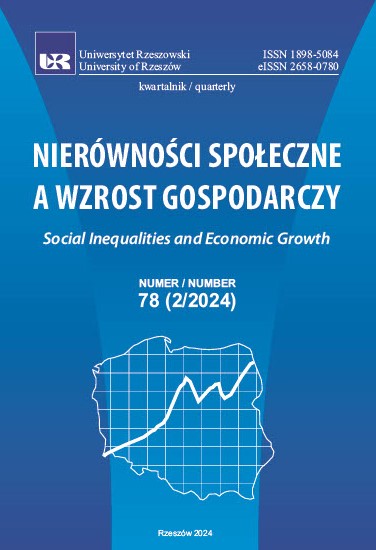Ubóstwo subiektywne i relatywne w krajach środkowoeuropejskich – według grup wiekowych
DOI:
https://doi.org/10.15584/nsawg.2024.2.1Słowa kluczowe:
ubóstwo subiektywne, ubóstwo relatywne, EU-SILC, kraje środkowoeuropejskieAbstrakt
W ocenie sytuacji społecznej oraz efektów działania instrumentów polityki dochodowej powszechnie korzysta się ze wskaźnika zagrożenia ubóstwem relatywnym. Jedną z alternatywnych miar jest wskaźnik ubóstwa subiektywnego identyfikujący osoby deklarujące niewystarczające dochody w odniesieniu do ich potrzeb. Celem badania jest porównanie wartości wskaźników ubóstwa relatywnego i subiektywnego w wybranych krajach środkowoeuropejskich ze szczególnym uwzględnieniem grup wiekowych respondentów. Weryfikowane jest przypuszczenie, że udział ubogich subiektywnie wśród ubogich relatywnie zmienia się w zależności od wieku. Analiza przeprowadzona została na podstawie danych EU-SILC obejmujących lata 2008–2018. Wyniki wskazują, że we wszystkich krajach zakres ubóstwa subiektywnego jest większy niż relatywnego. Litwa, Łotwa, Estonia oraz Słowacja w porównaniu do Polski, Węgier i Czech charakteryzują się większymi różnicami między analizowanymi w pracy miarami ubóstwa. Malejący w czasie zakres ubóstwa subiektywnego prowadzi do zmniejszenia się różnic między obiema miarami ubóstwa. Widoczna jest rozłączność grup ubogich, można wyodrębnić grupy tylko ubogie subiektywnie lub tylko relatywnie. Wyniki pokazują również malejącą liczbę ubogich subiektywnie wśród młodszych i większą liczbę ubogich relatywnie wśród starszych respondentów. Zaobserwowany trend w krajach Europy Środkowej wskazuje na pogłębiający się problem względnego ubóstwa materialnego najstarszych przy równoczesnym niezmienionym, a wręcz coraz lepszym poczuciu własnej sytuacji materialnej. Powyższe wyniki wskazują, że ubóstwo obiektywne względne i subiektywne opisują odmienne zjawiska.
Downloads
Bibliografia
Aidukaite, J., Hort, S.E.O. (2019). Editorial introduction: Baltic states after the crisis? The transformation of the welfare system and social problems. Journal of Baltic Studies, 50(1), 1–6. DOI: 10.1080/01629778.2019.1571754.
Budlender, D. (2003). The Debate about Household Headship. Social Dynamics: A Journal of African Studies, 29(2), 48–72. DOI: 10.1080/02533950308628675.
Buttler, F. (2013). What determines subjective poverty? An evaluation of the link between relative income poverty measures and subjective economic stress within the EU. DFG Research Unit Horizontal Europeanization. Oldenburg: Carl‐von‐Ossietzky‐Universität Oldenburg. Pobrane z: https://uol.de/fileadmin/user_upload/proj/horizontal/downloads/pre-prints/PP_HoEu_2013-01_buttler_subjective_poverty_0.pdf (2024.06.28).
Carletto, G., Zezza, A. (2006). Being poor, feeling poorer: Combining objective and subjective measures of welfare in Albania. Journal of Development Studies, 42(5), 739–760. DOI: 10.1080/00220380600741896.
Cleveland, W.S. (1979). Robust locally weighted regression and smoothing scatterplots. Journal of the American Statistical Association, 74, 829–836. DOI: 10.1080/ 01621459.1979.10481038.
Eurostat. (2018). Methodological Guidelines and Description of EU-SILC Target Variables. DocSILC065 (2018 operation [Version July 2019]).
Giełda, M. (2014). Prekarność a ubóstwo. W: J. Blicharz, L. Klat-Wertelecka, E. Rutkowska-Tomaszewska (red.), Ubóstwo w Polsce (s. 13–29). Wrocław: Wydział Prawa, Administracji i Ekonomii Uniwersytetu Wrocławskiego.
Goedhart, T., Halberstadr, V., Kapteyn, A., van Praag, B.M.S. (1977). The Poverty Line: Concept and Measurement. The Journal of Human Resources, 12(4), 503–520. DOI: 10.2307/145372.
Golinowska, S. (2018). O polskiej biedzie w latach 1990–2015. Definicje, miary i wyniki. Warszawa: Wydawnictwo Naukowe Scholar.
Hagenaars, A.J.M., van Praag, B.M.S. (1985). A synthesis of poverty line definitions. The Review of Income and Wealth, 31(2), 139–154. DOI: 10.1111/j.1475-4991.1985. tb00504.x.
Hansen, T., Slagsvold, B., Moum, T. (2008). Financial situation in old age: A satisfaction paradox or a result of accumulated wealth? Social Indicators Research, 89(2), 323–347. DOI: 10.1007/s11205-007-9234-z.
Hazelrigg, L.E., Hardy, M.A. (1997). Perceived income adequacy among older adults: Issues of conceptualization and measurement, with an analysis of data. Research on Aging, 19, 69–107. DOI: 10.1177/0164027597191004.
Hsieh, C. (2011). Money and happiness: does age make a difference? Ageing & Society, 31, 1289–1306. DOI: 10.1017/S0144686X10001431.
Koczan, Z. (2016). Being Poor, Feeling Poorer: Inequality, Poverty and Poverty Perceptions in the Western Balkans. IMF Working Paper, 16(31), 1–34.
Litwin, H., Sapir, E. (2009). Perceived Income Adequacy Among Older Adults in 12 countries: Finding from the Survey of Health, Ageing, Retirement in Europe. The Gerontologist, 49(3), 397–406. DOI: 10.1093/geront/gnp036.
Marks, G.N. (2007). Income poverty, subjective poverty and financial stress. Australian Government Social Policy Research Paper, 29, 1–94. DOI: 10.2139/ssrn.1728587.
Morawski, L., Domitrz, A. (2017). Subjective Approach to Assessing Poverty in Poland – Implications for Social Policy. Statistics in Transition new series, 18(3), 501–520. DOI: 10.21307.
Mysíková, M., Želinský, T., Garner, T.I., Večerník, J. (2019). Subjective Perceptions of Poverty and Objective Economic Conditions: Czechia and Slovakia a Quarter Century After the Dissolution of Czechoslovakia. Social Indicators Research, 145, 523– 550. DOI: 10.1007/s11205-019-02102-2.
Panek, T. (2008). Ubóstwo i nierówności: dylematy pomiaru. Pobrane z: https://stat.gov.pl/cps/rde/xbcr/gus/POZ_Ubostwo_i_nierownosci-dylematy_pomiaru.pdf (2024.06.28).
Panek, T., Zwierzchowski, J. (2016). Ubóstwo w krajach Unii Europejskiej. Ekonomista, 2, 180–199.
Peng, C., Yip, P.S.F., Law, Y.W. (2020). What Factors Beyond Economic Poverty Lead People in High-income Societies to Feel Poor? Evidence from Hong Kong. Social Indicators Research, 152, 991–1027. DOI: 10.1007/s11205-020-02419-3.
Pollak, R., Wales, T. (1979). Welfare Comparison and Equivalence Scale. American Economic Review, 69, 216–21.
Posel, D., Rogan, M. (2016). Measured as Poor versus Feeling Poor: Comparing Money-metric and Subjective Poverty Rates in South Africa. Journal of Human Development and Capabilities, 17(1), 55–73. DOI: 10.1080/19452829.2014.985198.
Rabušic, L. (1998). The Poverty of the Czech Elderly – Myth or Reality? Sociologický časopis. Czech Sociological Review, 6(1), 5–24. DOI: 10.13060/00380288.199. 34.11.02.
Ravallion, M. (2012). Poor, or Just Feeling Poor? On Using Subjective Data in Measuring Poverty. World Bank Policy Research Working Papers, 5968, 1–39.
Shaw, B. (1988). Poverty: absolute or relative? Journal of Applied Philosophy, 5(1), 27– 36. DOI: 10.1111/j.1468-5930.1988.tb00226.x.
Stoller, M.A., Stoller, E.P. (2003). Perceived income adequacy among elderly retirees. Journal of Applied Gerontology, 22, 230–251. DOI: 10.1177/0733464803022002004.
de Vos, K., Garner, T.I. (1991). An evaluation of subjective poverty definitions: Comparing results from the U.S. and the Netherlands. Review of Income and Wealth, 37(3), 267–285. DOI: 10.1111/j.1475-4991.1991.tb00371.x.
Vrooman, C.J. (2009). Rules of relief; institutions of social security, and their impact. The Hague: The Netherlands Institute of Social Research.
Wang, H., Zhao, Q., Bai, Y., Zhang, L., Yu, X. (2020). Poverty and Subjective Poverty in Rural China. Social Indicators Research, 150, 219–242. DOI: 10.1007/s11205-020- 02303-0.
Želinský, T., Mysíková, M., Garner, T.I. (2021). Trends in Subjective Income Poverty Rates in the European Union. The European Journal of Development Research, 34, 2493–2516. DOI: 10.1057/s41287-021-00457-2.
Pobrania
Opublikowane
Jak cytować
Numer
Dział
Licencja
Prawa autorskie (c) 2024 Uniwersytet Rzeszowski

Utwór dostępny jest na licencji Creative Commons Uznanie autorstwa – Użycie niekomercyjne – Bez utworów zależnych 4.0 Międzynarodowe.


